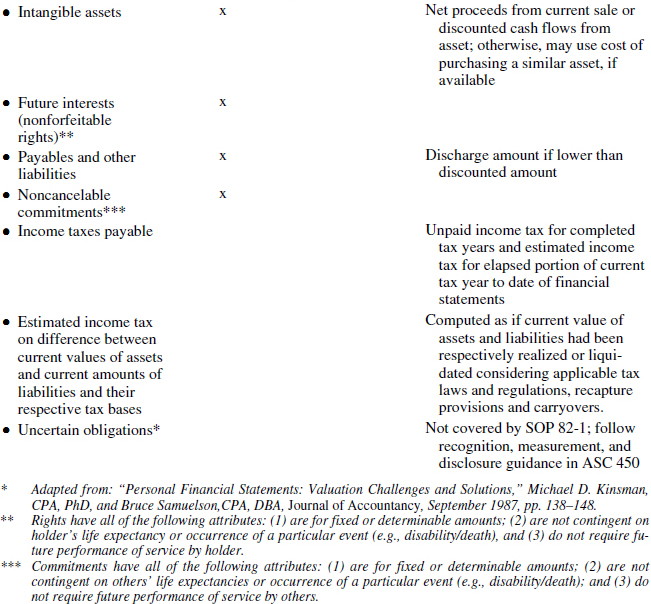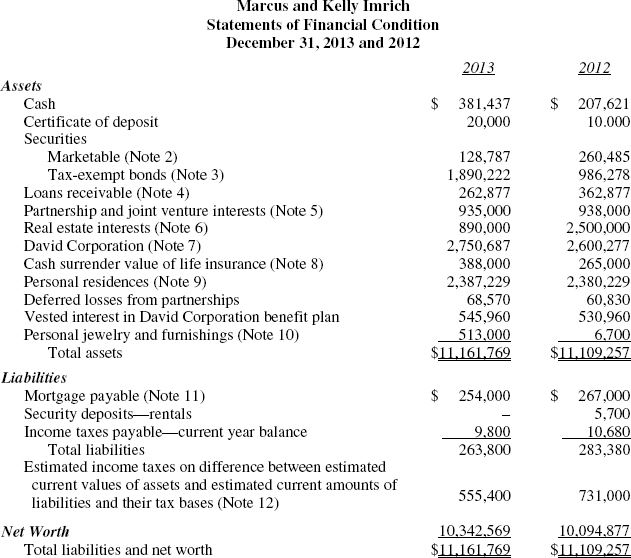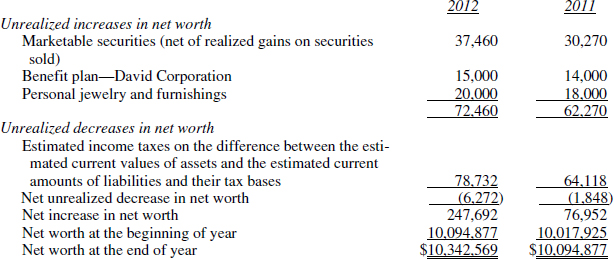14 ASC 274 PERSONAL FINANCIAL STATEMENTS
Example: Hypothetical Set of Personal Financial Statements
PERSPECTIVE AND ISSUES
Subtopic
ASC 274, Personal Financial Statements, consists of one topic:
- ASC 274-10, Overall, that addresses the preparation and presentation of financial statements of individuals or groups of related individuals (i.e., families).
Overview
Personal financial statements are generally prepared to organize and plan an individual's financial affairs on a more formal basis. Specific purposes that might require the preparation of personal financial statements include the obtaining of credit, income tax planning, retirement planning, gift and estate planning, or the public disclosure of financial affairs. Third-party recipients of personal financial statements use them in deciding whether to grant credit, in evaluating the financial condition of individuals, in assessing the financial affairs of public officials and candidates for public office, and for other purposes. Estimated current values of assets and liabilities are almost always specified for use in the preparation of personal financial statements as this information is more relevant to users than historical cost.
DEFINITIONS OF TERMS
Source: ASC 274-10-20
Estimated current value of an asset. The amount for which an item could be exchanged between a buyer and a seller, each of whom is well informed and willing, and neither of whom is compelled to buy or sell.
Net worth. The difference between total assets and total liabilities, after deducting estimated income taxes on the differences between the estimated current values of assets and the estimated current amounts of liabilities and their income tax bases.
CONCEPTS, RULES, AND EXAMPLES
Personal financial statements can be prepared for an individual, jointly for a husband and wife, or collectively for a family.
Personal financial statements consist of:
- Statement of financial condition—The only required financial statement, the statement of financial condition presents the estimated current values of assets and the estimated current amounts of liabilities. A liability is recognized for estimated income taxes on the difference between the asset and liability amounts set forth in the statement of financial condition and their respective income tax bases. Naturally, the residual amount after deducting the liabilities (including the estimated income tax liability) from the assets is presented as net worth at that date.
- Statement of changes in net worth—An optional statement that presents the primary sources of increases and decreases in net worth over a period of time.
- Comparative financial statements—The inclusion of a comparison of the current period's financial statements with one or more previous period's financial statements is optional.
(Source: 274-10-45-4)
Basis of presentation.
The accrual basis, rather than the cash basis, of accounting is used in preparing personal financial statements. The presentation of personal financial statements does not require the classification of assets and liabilities as current and noncurrent. Instead, assets and liabilities are presented in order of liquidity and maturity.
Measurement.
In personal financial statements, assets are presented at their estimated current values. This is defined by ASC 274 as the amount at which the item could be exchanged between a buyer and a seller, assuming both parties are well informed, and neither party is compelled to buy or sell. Disposal costs, if material, are deducted to arrive at current values. It is important to note that this definition has not been amended to conform to the definition of fair value as set forth in ASC 820. The definition of estimated current value in ASC 274 more closely resembles the definition of fair value less cost to sell that is used in FAS ASC 360, Property, Plant, and Equipment. Futhermore, ASC 274 specifically provides for adjustment of the current value of securities for the effects of transferability restrictions or the effects of the investor holding a large block of securities (blockage factor). Adjustments for blockage factors are specifically prohibited by ASC 820.
A specialist may need to be consulted in the determination of the current value of certain types of assets (e.g., works of art, jewelry, restricted securities, investments in closely held businesses, and real estate). If property is held in joint tenancy, as community property, or through a similar joint ownership arrangement, the finanacial statement preparer may require the advice of an attorney to determine, under applicable state law, the portion of the property interest that should be included in the individual's assets.
Liabilities are presented at the lesser of the discounted amount of cash to be paid or the current cash settlement amount. The discount rate should be the rate implicit in the transaction that gave rise to the liability. As a practical matter, the preparer may decide to use the individual's incremental borrowing rate at the inception of the transaction to discount the remaining cash flows.
The use of information about recent transactions involving similar types of assets and liabilities, in similar circumstances, constitutes a satisfactory means of determining the estimated current value of an asset and the estimated current amount of a liability. If recent transactional information cannot be obtained, it is permissible to use other methods (e.g., capitalization of past or prospective earnings, the use of liquidation values, the adjustment of historical cost based on changes in a specific price index, the use of appraisals, and the use of the discounted amounts of projected cash receipts and payments). The methods used should be followed consistently from period to period unless the facts and circumstances dictate a change to different methods.
Income taxes payable are to include unpaid income taxes for completed tax years and the estimated amount for the elapsed portion of the current tax year. Additionally, personal financial statements are required to include estimated income tax on the difference between the current value (amount) of assets (liabilities) and their respective income tax bases as if they had been realized or liquidated.
The table below summarizes the methods of determining “estimated current values” for assets and “estimated current amounts” for liabilities.
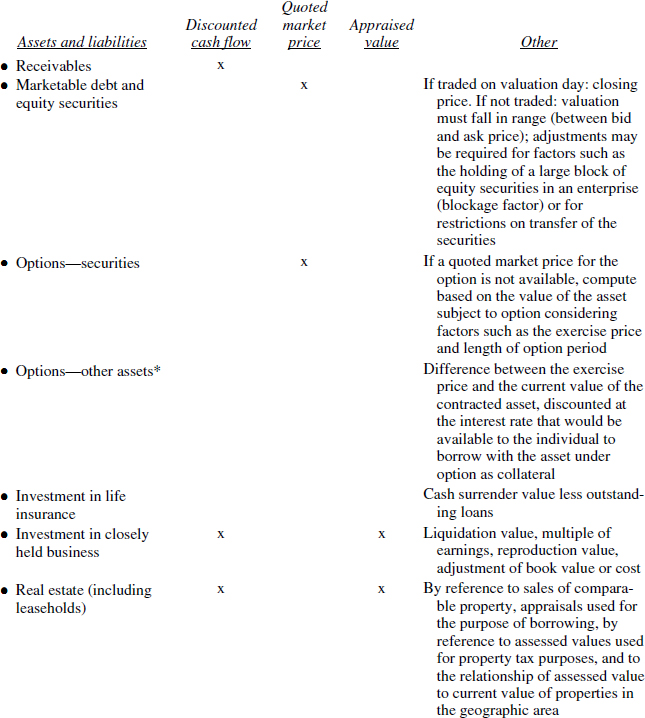
Business interests that comprise a large portion of a person's total assets should be presented separately from other investments. An investment in a separate entity that is marketable as a going concern (e.g., a closely held corporation) should be presented as one amount. If the investment is a limited business activity, not conducted in a separate legal entity, separate asset and liability amounts should be shown (e.g., investment in real estate and related mortgage; only the person's beneficial interest in the investment is included in his/her personal financial statements).
The preparer must decide whether to value the net investment him/herself or to engage a qualified specialist. The possible valuation methods available are discounted cash flow, appraised value, liquidation value, multiple of earnings, reproduction value, adjustment of book value (e.g., equity method), or cost. In some cases, it is appropriate to use a combination of approaches to reasonably estimate the current value.
Disclosures.
The following disclosures are typically made in either the body of the financial statements or in the accompanying notes. (This list is not all-inclusive.)
- A clear identification of the individuals covered by the financial statements
- That assets are presented at their estimated current values and liabilities are presented at their estimated current amounts
- The methods used in determining the estimated current values of major assets and the estimated current amounts of major liabilities or major categories of assets and liabilities, and
- Changes in methods used in 3 from one period to the next
- If assets held jointly by the person and by others included in the statements, the nature of the joint ownership
- If the person's investment portfolio is material in relation to his or her other assets and is concentrated in one or a few companies or industries, the names of the companies or industries and the estimated current values of the securities
- If the person has a material investment in a closely held business:
- The name of the company
- The person's percentage of ownership
- The nature of the business
- Summarized financial information about assets, liabilities, and results of operations for the most recent year based on the businesses' own financial statements as well as the basis of presentation (e.g., GAAP, cash basis, income tax basis, etc.), and any significant loss contingencies
- Description of intangible assets and their estimated useful lives
- The face amount of life insurance the individual owns
- Certain nonforfeitable rights, such as pensions based on life expectancy
- The methods and assumptions used to calculate estimated income taxes on the differences between the estimated current values of assets and the estimated current amounts of liabilities and their tax bases as well as a statement that the provision will probably differ from the amounts eventually paid as the timing and method of disposal as well as changes in the tax laws and regulations will affect the actual taxes to be paid
- Unused operating loss and capital loss carryforwards and any other unused deductions or credits and, if applicable, the tax year in which they expire (under the current income tax code, there will frequently be unused alternative minimum tax credit carryforwards)
- The differences between the estimated current values of major assets and the estimated current amounts of major liabilities or categories of assets and liabilities and their tax bases
- Maturities, interest rates, collateral, and other pertinent details relating to receivables and debt
- Certain noncancellable commitments such as operating leases.
(Source: ASC 274-10-50-2)
EXAMPLE: HYPOTHETICAL SET OF PERSONAL FINANCIAL STATEMENTS
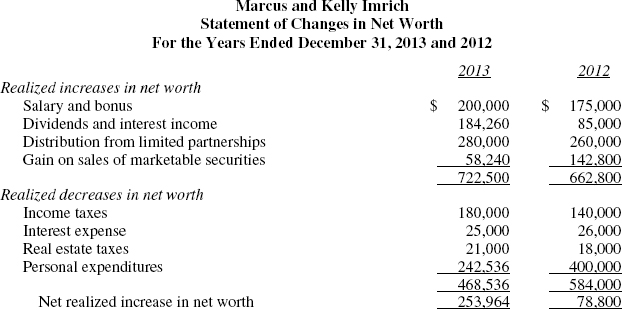
Marcus and Kelly Imrich
Notes to Financial Statements
Note 1: The accompanying financial statements include the assets and liabilities of Marcus and Kelly Imrich. Assets are stated at their estimated current values, and liabilities at their estimated current amounts.
Note 2: The estimated current values of marketable securities are either (1) their quoted closing prices or (2) for securities not traded on the financial statement date, amounts that fall within the range of quoted bid and asked prices.
Marketable securities consist of the following:

Note 3: The interest income from state and municipal bonds is generally not subject to federal income taxes but is, except in certain cases, subject to state income tax and federal alternative minimum tax.
Note 4: The loan receivable from Carol Parker, Inc. matures January 2020 and bears interest at the prime rate.
Note 5: Partnership and joint venture interests consist of the following:

Note 6: Mr. and Mrs. Imrich own a one-half interest in an apartment building in DeKalb, Illinois. The estimated current value was determined by Mr. and Mrs. Imrich. Their income tax basis in the apartment building was $1,000,000 for both 2013 and 2012.
Note 7: Kelly Imrich owns 75% of the common stock of the David Corporation. A condensed statement of assets, liabilities, and stockholders' equity (income tax basis) of David Corporation as of December 31, 2013 and 2012 is summarized below.

Note 8: At December 31, 2013 and 2012, Marcus Imrich owned a $1,000,000 whole life insurance policy. Mrs. Imrich is the sole beneficiary under the policy.
Note 9: The estimated current values of the personal residences are their purchase prices plus their cost of improvements. Both residences were purchased in 2011.
Note 10: The estimated current values of personal effects and jewelry are the appraised values of those assets, determined by an independent appraiser for insurance purposes.
Note 11: The mortgage (collateralized by the residence) is payable in monthly installments of $2,479, including interest at an annual rate of 6% through 2025.
Note 12: The estimated current amounts of liabilities at December 31, 2013, and December 31, 2012, equaled their income tax bases. Estimated income taxes have been provided on the excess of the estimated current values of assets over their tax bases as if the estimated current values of the assets had been realized on the dates of the statements of financial condition, using applicable income tax laws and regulations. The provision will probably differ from the amounts of income taxes that eventually will be paid because those amounts are determined by the timing and the method of disposal or realization and the income tax laws and regulations in effect at the time of disposal or realization.
The excess of estimated current values of major assets over their income tax bases are:


